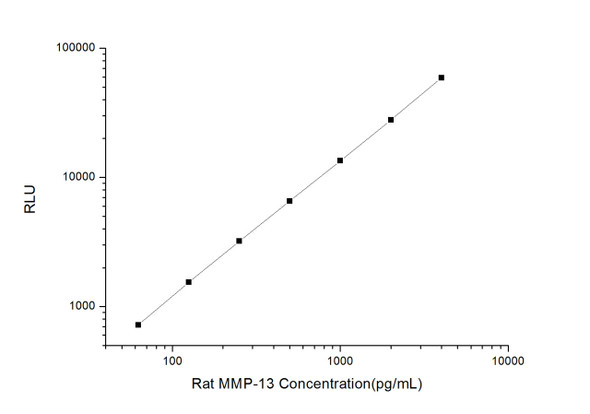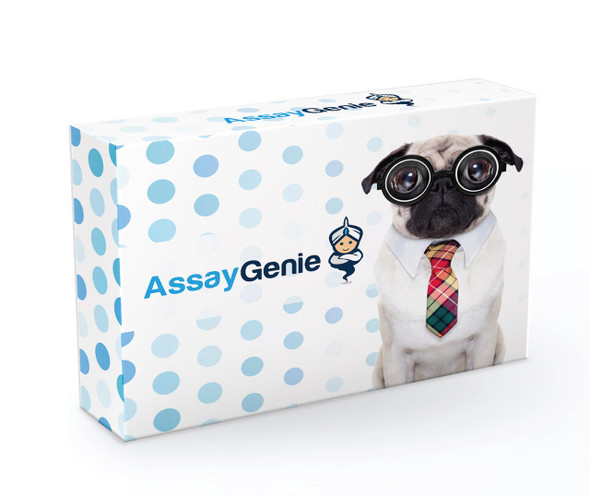Human Cell Biology ELISA Kits 3
Human MMP-13 (Matrix Metalloproteinase 13) CLIA Kit (HUES00121)
- SKU:
- HUES00121
- Product Type:
- ELISA Kit
- ELISA Type:
- CLIA Kit
- Size:
- 96 Assays
- Sensitivity:
- 46.88pg/mL
- Range:
- 78.13-5000pg/mL
- ELISA Type:
- Sandwich
- Synonyms:
- MMP13, CLG3, MANDP1, Collagenase 3
- Reactivity:
- Human
- Sample Type:
- Serum, plasma and other biological fluids
- Research Area:
- Cell Biology
Description
| Assay type: | Sandwich |
| Format: | 96T |
| Assay time: | 4.5h |
| Reactivity: | Human |
| Detection method: | Chemiluminescence |
| Detection range: | 78.13-5000 pg/mL |
| Sensitivity: | 46.88 pg/mL |
| Sample volume: | 100µL |
| Sample type: | Serum, plasma and other biological fluids |
| Repeatability: | CV < 15% |
| Specificity: | This kit recognizes Human MMP-13 in samples. No significant cross-reactivity or interference between Human MMP-13 and analogues was observed. |
This kit uses Sandwich-CLIA as the method. The micro CLIA plate provided in this kit has been pre-coated with an antibody specific to Human MMP-13. Standards or samples are added to the appropriate micro CLIA plate wells and combined with the specific antibody. Then a biotinylated detection antibody specific for Human MMP-13 and Avidin-Horseradish Peroxidase (HRP) conjugate are added to each micro plate well successively and incubated. Free components are washed away. The substrate solution is added to each well. Only those wells that contain Human MMP-13, biotinylated detection antibody and Avidin-HRP conjugate will appear fluorescence. The Relative light unit (RLU) value is measured spectrophotometrically by the Chemiluminescence immunoassay analyzer. The RLU value is positively associated with the concentration of Human MMP-13. The concentration of Human MMP-13 in the samples can be calculated by comparing the RLU of the samples to the standard curve.
| UniProt Protein Function: | MMP13: Degrades collagen type I. Does not act on gelatin or casein. Could have a role in tumoral process. Defects in MMP13 are the cause of spondyloepimetaphyseal dysplasia Missouri type (SEMD-MO). A bone disease characterized by moderate to severe metaphyseal changes, mild epiphyseal involvement, rhizomelic shortening of the lower limbs with bowing of the femora and/or tibiae, coxa vara, genu varum and pear-shaped vertebrae in childhood. Epimetaphyseal changes improve with age. Defects in MMP13 are the cause of metaphyseal anadysplasia type 1 (MANDP1). Metaphyseal anadysplasia consists of an abnormal bone development characterized by severe skeletal changes that, in contrast with the progressive course of most other skeletal dysplasias, resolve spontaneously with age. Clinical characteristics are evident from the first months of life and include slight shortness of stature and a mild varus deformity of the legs. Patients attain a normal stature in adolescence and show improvement or complete resolution of varus deformity of the legs and rhizomelic micromelia. Belongs to the peptidase M10A family. |
| UniProt Protein Details: | Protein type:Secreted; EC 3. 4. 24. -; Secreted, signal peptide; Protease Chromosomal Location of Human Ortholog: 11q22. 3 Cellular Component: extracellular region Molecular Function:calcium ion binding; collagen binding; metalloendopeptidase activity; serine-type endopeptidase activity; zinc ion binding Biological Process: collagen catabolic process; extracellular matrix disassembly Disease: Spondyloepimetaphyseal Dysplasia, Missouri Type |
| NCBI Summary: | This gene encodes a member of the peptidase M10 family of matrix metalloproteinases (MMPs). Proteins in this family are involved in the breakdown of extracellular matrix in normal physiological processes, such as embryonic development, reproduction, and tissue remodeling, as well as in disease processes, such as arthritis and metastasis. The encoded preproprotein is proteolytically processed to generate the mature protease. This protease cleaves type II collagen more efficiently than types I and III. It may be involved in articular cartilage turnover and cartilage pathophysiology associated with osteoarthritis. Mutations in this gene are associated with metaphyseal anadysplasia. This gene is part of a cluster of MMP genes on chromosome 11. [provided by RefSeq, Jan 2016] |
| UniProt Code: | P45452 |
| NCBI GenInfo Identifier: | 1168998 |
| NCBI Gene ID: | 4322 |
| NCBI Accession: | P45452. 1 |
| UniProt Secondary Accession: | P45452,Q6NWN6, A8K846, B2RCZ3, |
| UniProt Related Accession: | P45452 |
| Molecular Weight: | 53,820 Da |
| NCBI Full Name: | Collagenase 3 |
| NCBI Synonym Full Names: | matrix metallopeptidase 13 |
| NCBI Official Symbol: | MMP13 |
| NCBI Official Synonym Symbols: | CLG3; MANDP1; MMP-13 |
| NCBI Protein Information: | collagenase 3 |
| UniProt Protein Name: | Collagenase 3 |
| UniProt Synonym Protein Names: | Matrix metalloproteinase-13; MMP-13 |
| Protein Family: | Collagenase |
| UniProt Gene Name: | MMP13 |
| UniProt Entry Name: | MMP13_HUMAN |
As the RLU values of the standard curve may vary according to the conditions of the actual assay performance (e. g. operator, pipetting technique, washing technique or temperature effects), the operator should establish a standard curve for each test. Typical standard curve and data is provided below for reference only.
| Concentration (pg/mL) | RLU | Average | Corrected |
| 5000 | 55859 66653 | 61256 | 61233 |
| 2500 | 33537 35171 | 34354 | 34331 |
| 1250 | 19542 16796 | 18169 | 18146 |
| 625 | 9025 9759 | 9392 | 9369 |
| 312.5 | 4939 4727 | 4833 | 4810 |
| 156.25 | 2536 2486 | 2511 | 2488 |
| 78.13 | 1278 1400 | 1339 | 1316 |
| 0 | 22 24 | 23 | -- |
Precision
Intra-assay Precision (Precision within an assay): 3 samples with low, mid range and high level Human MMP-13 were tested 20 times on one plate, respectively.
Inter-assay Precision (Precision between assays): 3 samples with low, mid range and high level Human MMP-13 were tested on 3 different plates, 20 replicates in each plate.
| Intra-assay Precision | Inter-assay Precision | |||||
| Sample | 1 | 2 | 3 | 1 | 2 | 3 |
| n | 20 | 20 | 20 | 20 | 20 | 20 |
| Mean (pg/mL) | 248.29 | 763.90 | 2041.85 | 249.21 | 747.59 | 1876.96 |
| Standard deviation | 23.31 | 62.41 | 176.21 | 22.85 | 79.32 | 126.51 |
| C V (%) | 9.39 | 8.17 | 8.63 | 9.17 | 10.61 | 6.74 |
Recovery
The recovery of Human MMP-13 spiked at three different levels in samples throughout the range of the assay was evaluated in various matrices.
| Sample Type | Range (%) | Average Recovery (%) |
| Serum (n=5) | 99-116 | 106 |
| EDTA plasma (n=5) | 89-104 | 95 |
| Cell culture media (n=5) | 99-115 | 106 |
Linearity
Samples were spiked with high concentrations of Human MMP-13 and diluted with Reference Standard & Sample Diluent to produce samples with values within the range of the assay.
| Serum (n=5) | EDTA plasma (n=5) | Cell culture media (n=5) | ||
| 1:2 | Range (%) | 89-102 | 97-112 | 92-108 |
| Average (%) | 95 | 104 | 100 | |
| 1:4 | Range (%) | 87-98 | 84-96 | 87-99 |
| Average (%) | 92 | 91 | 93 | |
| 1:8 | Range (%) | 103-121 | 95-112 | 98-114 |
| Average (%) | 110 | 102 | 105 | |
| 1:16 | Range (%) | 102-119 | 89-99 | 88-100 |
| Average (%) | 109 | 94 | 95 |
An unopened kit can be stored at 4°C for 1 month. If the kit is not used within 1 month, store the items separately according to the following conditions once the kit is received.
| Item | Specifications | Storage |
| Micro CLIA Plate(Dismountable) | 8 wells ×12 strips | -20°C, 6 months |
| Reference Standard | 2 vials | |
| Concentrated Biotinylated Detection Ab (100×) | 1 vial, 120 µL | |
| Concentrated HRP Conjugate (100×) | 1 vial, 120 µL | -20°C(shading light), 6 months |
| Reference Standard & Sample Diluent | 1 vial, 20 mL | 4°C, 6 months |
| Biotinylated Detection Ab Diluent | 1 vial, 14 mL | |
| HRP Conjugate Diluent | 1 vial, 14 mL | |
| Concentrated Wash Buffer (25×) | 1 vial, 30 mL | |
| Substrate Reagent A | 1 vial, 5 mL | 4°C (shading light) |
| Substrate Reagent B | 1 vial, 5 mL | 4°C (shading light) |
| Plate Sealer | 5 pieces | |
| Product Description | 1 copy | |
| Certificate of Analysis | 1 copy |
- Set standard, test sample and control (zero) wells on the pre-coated plate and record theirpositions. It is recommended to measure each standard and sample in duplicate. Note: addall solutions to the bottom of the plate wells while avoiding contact with the well walls. Ensuresolutions do not foam when adding to the wells.
- Aliquot 100µl of standard solutions into the standard wells.
- Add 100µl of Sample / Standard dilution buffer into the control (zero) well.
- Add 100µl of properly diluted sample (serum, plasma, tissue homogenates and otherbiological fluids. ) into test sample wells.
- Cover the plate with the sealer provided in the kit and incubate for 90 min at 37°C.
- Aspirate the liquid from each well, do not wash. Immediately add 100µL of BiotinylatedDetection Ab working solution to each well. Cover the plate with a plate seal and gently mix. Incubate for 1 hour at 37°C.
- Aspirate or decant the solution from the plate and add 350µL of wash buffer to each welland incubate for 1-2 minutes at room temperature. Aspirate the solution from each well andclap the plate on absorbent filter paper to dry. Repeat this process 3 times. Note: a microplatewasher can be used in this step and other wash steps.
- Add 100µL of HRP Conjugate working solution to each well. Cover with a plate seal andincubate for 30 min at 37°C.
- Aspirate or decant the solution from each well. Repeat the wash process for five times asconducted in step 7.
- Add 100µL of Substrate mixture solution to each well. Cover with a new plate seal andincubate for no more than 5 min at 37°C. Protect the plate from light.
- Determine the RLU value of each well immediately.






